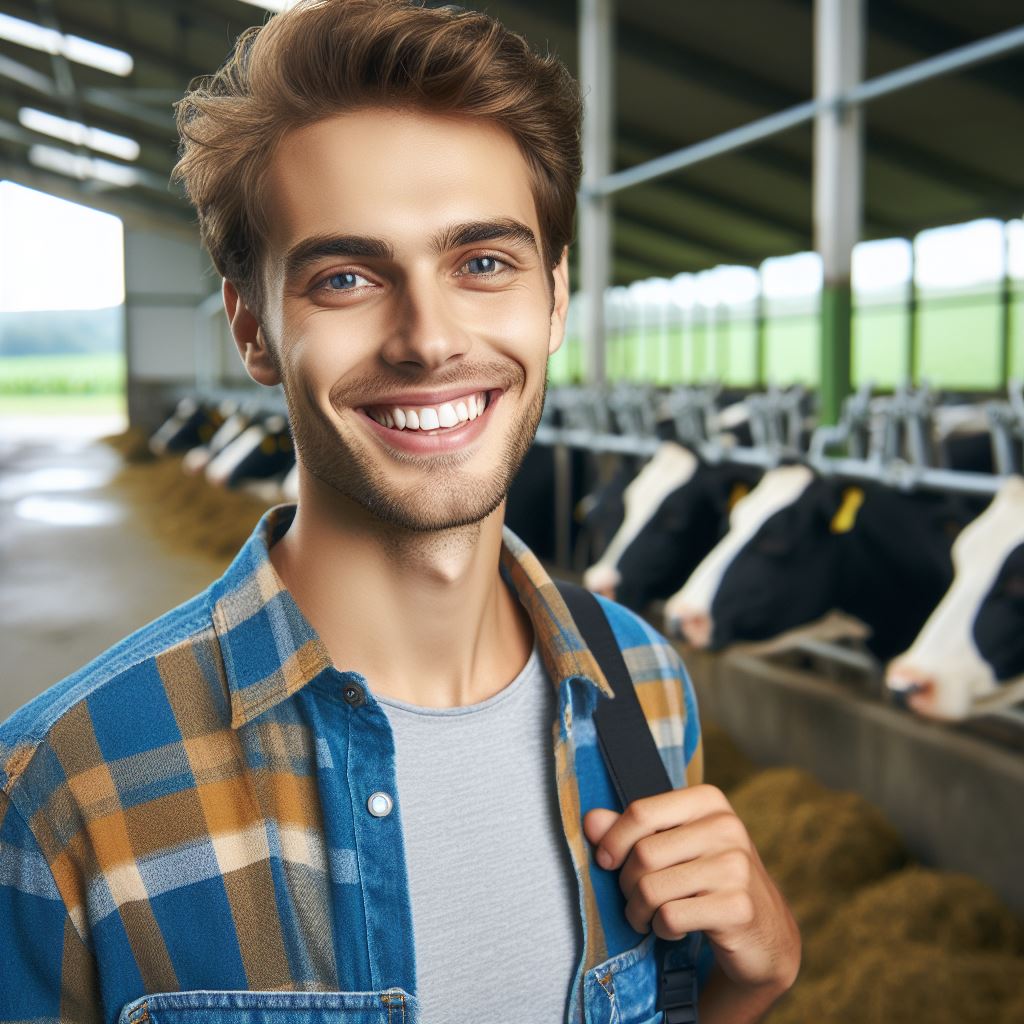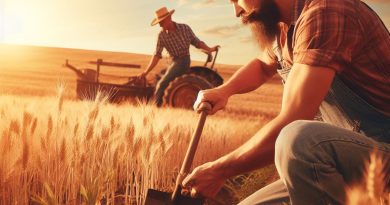Dairy Farmer’s Journey to Sustainability
Last Updated on February 18, 2024
Introduction
The dairy farmer journey to sustainability, transitioning to sustainability, is pivotal for environmental preservation in dairy farming.
Amidst contemporary agricultural challenges, sustainability ensures longevity and resilience.
In this section, we embark on a journey alongside a dairy farmer, navigating the intricate landscape of sustainable practices.
By understanding the significance of sustainability in the dairy industry, we can uncover innovative approaches and transformative strategies employed by farmers striving for ecological balance.
Through their experiences and insights, we gain a deeper appreciation for the interconnectedness of agriculture and the environment, as well as the imperative need to adopt sustainable practices.
Join us as we explore the farmer’s endeavors, challenges, and triumphs in their quest towards a more sustainable future for dairy farming.
Challenges and Motivations
- Limited access to resources such as land, water, and feed, making it challenging to expand sustainably.
- The high cost of implementing sustainable farming practices, including investing in renewable energy sources.
- Dealing with unpredictable weather patterns and climate change, which affect crop and pasture yields.
- Balancing the need for increased milk production while minimizing the environmental impact.
- Adapting to changing consumer demands for ethically produced and environmentally friendly dairy products.
Environmental, Economic, and Social Motivations for Pursuing Sustainability
1. Environmental motivations
Reducing greenhouse gas emissions and minimizing the ecological footprint of dairy farming.
Preserving biodiversity and protecting natural resources, such as soil and water.
Minimizing pollution caused by run-off from dairy farms into water bodies.
2. Economic motivations
Improving the efficiency of dairy operations to reduce costs and increase profitability.
Accessing new markets and meeting the growing demand for sustainable dairy products.
Reducing reliance on external inputs by implementing sustainable farming practices.
3. Social motivations
Aligning farming practices with community values and expectations.
Ensuring the well-being of animals through ethical treatment and good welfare practices.
Being a responsible member of the community by contributing to its economic and social development.
Personal Experiences of a Dairy Farmer on the Journey to Sustainability
John Smith, a dairy farmer from rural Wisconsin, embarked on a journey towards sustainability driven by his belief in the importance of conservation.
- Facing the challenge of limited land availability, John implemented rotational grazing to optimize pasture use and reduce reliance on purchased feeds.
- To address the high cost of sustainable practices, John sought financial assistance through grants and sustainable agriculture programs.
- Experienced extreme weather events, including droughts and heavy rains, caused John to invest in irrigation and stormwater management systems.
- He adopted precision farming techniques, utilizing technology to optimize resource allocation and minimize waste.
- John altered his herd management practices, focusing on genetics and nutrition to improve milk production efficiency while lowering environmental impact.
- Engaging with local consumers, John promoted the benefits of sustainable dairy farming and educated them on the importance of supporting local producers.
- John actively collaborated with other dairy farmers, sharing knowledge and experiences to collectively strive towards sustainability.
- Over time, John saw the positive impacts of his efforts, including increased farm profitability and improved relationships with the community.
In fact, dairy farmers face various challenges, both practical and financial, when striving for sustainability.
However, the motivation to protect the environment, enhance the economy, and maintain social responsibility ultimately drives them towards a more sustainable future.
Read: Tractor Tracks: Innovations in Farming
Implementing Sustainable Practices
As the world becomes increasingly aware of the importance of sustainability, the agriculture industry is also making efforts to adopt sustainable practices.
This includes dairy farming, where farmers are embracing various methods to reduce their environmental impact and promote long-term sustainability.
In this section, we will explore the sustainable practices implemented by a dairy farmer and their benefits.
Shift towards organic farming
- The dairy farmer has transitioned to organic farming methods, avoiding the use of synthetic fertilizers and pesticides.
- Organic farming promotes biodiversity, reduces soil erosion, and improves the overall quality of the environment.
Conservation of water
- The farmer emphasizes the importance of water conservation by implementing various measures on the farm.
- Water-saving technologies such as drip irrigation systems and rainwater harvesting are utilized.
- Regular maintenance and repair of water systems help in minimizing wastage and maximizing efficient water usage.
Energy consumption reduction
- The dairy farmer focuses on reducing energy consumption to minimize the farm’s carbon footprint.
- High-efficiency equipment and energy-saving practices, such as using LED lighting and optimizing ventilation systems, are employed.
- The farmer also explores options for renewable energy sources, such as solar panels or wind turbines, to power the farm.
Waste reduction and management
- The farmer adopts waste reduction strategies, such as recycling and composting, to minimize waste generation.
- Manure is treated as a valuable resource, being carefully managed and utilized as organic fertilizer.
- The proper disposal of hazardous materials and the use of eco-friendly packaging contribute to waste reduction efforts.
Soil management
- The dairy farmer recognizes the importance of maintaining healthy soil through proper management practices.
- Soil testing is conducted regularly to determine nutrient deficiencies and ensure proper fertilization.
- Cover cropping, crop rotation, and the use of green manure help to improve soil structure and increase organic matter content.
Biodiversity promotion
- The farmer understands that biodiversity plays a crucial role in the ecosystem and implements measures to support it.
- Natural habitats are preserved on the farm to provide a conducive environment for wildlife and beneficial insects.
- Planting native species and creating pollinator gardens contribute to enhancing biodiversity and promoting natural pollination.
Embracing sustainable practices not only benefits the environment but also has a positive impact on the dairy farmer’s business.
By adopting organic farming methods, the farmer can potentially access premium markets that value sustainable produce.
Water and energy conservation measures help in reducing operational costs, while waste reduction strategies result in cost savings and improved efficiency.
Moreover, by focusing on proper soil management and biodiversity, the farm becomes more resilient to climate change and other environmental challenges.
The diverse ecosystem contributes to improved soil fertility, pest control, and overall ecosystem balance.
In short, the dairy farmer’s journey towards sustainability involves a comprehensive approach that covers various aspects of farming.
By shifting towards organic farming, conserving water, reducing waste, managing soil, and promoting biodiversity, the farmer is making significant strides in minimizing environmental impact and ensuring long-term sustainability.
Such practices not only benefit the farmer but also contribute to the well-being of the planet.
Read: Barns and Bonds: Community Farming

Collaboration and Community Engagement
Role of partnerships and collaborations in achieving sustainability goals.
Partnerships and collaborations play a crucial role in achieving sustainability goals for dairy farmers.
Through collaboration, farmers can pool resources, knowledge, and expertise, leading to more effective and sustainable practices.
Farmer’s involvement in local sustainable agriculture groups
The farmer in this case has actively involved themselves in local sustainable agriculture groups, recognizing the importance of community engagement in their journey towards sustainability.
By joining these groups, the farmer gains access to a network of like-minded individuals who share a passion for sustainable farming.
Benefits of sharing knowledge and resources within the farming community.
Sharing knowledge and resources within the farming community brings numerous benefits.
The farmer understands that by sharing their experiences and insights, they can inspire and educate others, ultimately leading to a more sustainable agriculture industry.
Through collaboration, farmers can also exchange ideas, adopt innovative techniques, and collectively address challenges that arise in their pursuit of sustainability.
Farmer’s efforts to engage with the local community and raise awareness about sustainable farming practices.
The farmer has made efforts to engage with the local community and raise awareness about sustainable farming practices.
By hosting educational events and workshops, the farmer aims to showcase the importance of sustainable agriculture and the positive impact it can have on the environment and community.
This engagement fosters a sense of shared responsibility and empowers individuals to make informed choices about their food sources.
Collaboration and community engagement also enable farmers to access additional support and resources.
By forming partnerships with local businesses, organizations, and government agencies, the farmer can secure funding for sustainability projects and gain access to specialized knowledge and technology.
These partnerships provide a platform for farmers to amplify their voices and advocate for sustainable farming practices on a larger scale.
Furthermore, collaboration and community engagement create a sense of camaraderie among farmers, fostering a supportive and encouraging environment.
By working together towards common sustainability goals, farmers can provide mutual support, celebrate successes, and navigate challenges more effectively.
This sense of community also strengthens the farmer’s commitment to sustainability, as they feel part of a larger movement dedicated to preserving the environment and ensuring a sustainable future.
In essence, partnerships and collaborations play a pivotal role in the journey of dairy farmers towards sustainability.
Through active involvement in local sustainable agriculture groups, sharing knowledge and resources, engaging with the local community, and forming partnerships, the farmer can accelerate their progress towards sustainable farming practices.
Collaboration not only enhances the farmer’s knowledge and resources but also fosters a sense of community and collective responsibility for the environment and the future of agriculture.
Read: Tilling Tales: A Family Farm History
Achievements and Future Goals
Achievements and milestones reached by the dairy farmer in their sustainability journey.
The dairy farmer’s journey towards sustainability has been marked by significant achievements and important milestones.
These accomplishments have not only had a positive impact on the farm’s productivity and bottom line but have also set the stage for future goals and continuous improvement.
- Installation of Solar Panels: One of the early achievements in the farmer’s sustainability journey was the installation of solar panels to generate renewable energy for the farm. This not only reduced the farm’s reliance on fossil fuels but also resulted in significant cost savings.
- Transition to Organic Feed: Another milestone achieved by the dairy farmer was the transition to organic feed for their cattle. This decision not only improved the quality of the milk produced but also aligned with consumer demand for organic dairy products.
- Water Conservation Efforts: The farmer implemented various water conservation measures, including the installation of efficient irrigation systems and the recycling of water used for cleaning the milking equipment. These efforts reduced water consumption and contributed to the farm’s sustainability goals.
- Improved Waste Management: The farmer established a comprehensive waste management system, which included proper composting of manure and utilizing it as nutrient-rich fertilizer for the fields. This initiative reduced waste and provided a sustainable solution for soil fertility.
- Introduction of Precision Farming Techniques: The dairy farmer embraced precision farming techniques, such as GPS-guided machinery and digital monitoring systems, to optimize resource usage and improve overall efficiency. These technological advancements led to increased productivity and reduced environmental impact.
Positive Impact on Productivity and Bottom Line
The implementation of sustainable practices on the farm has had a significant positive impact on both productivity and the bottom line.
The farmer’s commitment to sustainability has resulted in several benefits:
- Increased Milk Production: The transition to organic feed and the improved management of farm resources have led to healthier and more productive cattle, resulting in a higher milk yield.
- Better Product Quality: The organic feed and sustainable practices have improved the quality of the milk, making it more desirable to both consumers and dairy processors. This has opened up new market opportunities for the farmer.
- Cost Savings: The adoption of renewable energy sources, efficient irrigation systems, and precision farming techniques has reduced operational costs, leading to significant savings for the farmer.
- Enhanced Reputation: The farmer’s commitment to sustainability has enhanced their reputation within the industry and among consumers. This has resulted in increased brand loyalty and market recognition.
Future Goals and Commitment to Continuous Improvement
The dairy farmer is not resting on past achievements and is committed to continuous improvement. They have set ambitious goals for the future, including:
- Transitioning to 100% Renewable Energy: The farmer aims to further reduce their carbon footprint by transitioning to 100% renewable energy sources, such as wind or biogas.
- Implementing Regenerative Agriculture Practices: The farmer plans to adopt regenerative agriculture practices, such as cover cropping and rotational grazing, to enhance soil health and biodiversity on the farm.
- Expanding Market Reach: The farmer is determined to expand their market reach by collaborating with local retailers and exploring opportunities for direct-to-consumer sales.
- Sharing Knowledge and Inspiring Others: The farmer wants to serve as a role model for other dairy farmers by sharing their journey and experiences, providing guidance, and encouraging the adoption of sustainable practices.
Potential for Scaling Up Sustainable Practices
The achievements and future goals of the dairy farmer highlight the potential for scaling up sustainable practices in the agriculture industry.
By showcasing the positive outcomes and benefits, the farmer can inspire and motivate others to follow suit.
This can lead to a wider adoption of sustainable practices, not only benefiting individual farmers but also contributing to a more sustainable and environmentally friendly agriculture sector as a whole.
Read: Soil and Sweat: The Reality of Farming
Conclusion
Throughout the dairy farmer’s journey to sustainability, they have encountered challenges and made significant changes to their practices.
They have embraced sustainable farming methods, such as reducing greenhouse gas emissions and conserving water resources.
These practices are not only beneficial for their farm’s profitability, but also for the environment and the community.
It is evident that sustainable practices in the dairy farming industry are crucial for a sustainable future.
By implementing these practices, farmers can contribute to reducing the negative impacts of agriculture on the environment.
Sustainable agriculture also helps promote biodiversity, soil health, and animal welfare.
As readers, it is essential to support and promote sustainable agriculture in our own communities.
This can be done by choosing to buy dairy products from farmers practicing sustainable methods.
By supporting these farmers, we are encouraging the adoption of sustainable practices throughout the industry.
In review, the dairy farmer’s journey to sustainability highlights the importance of responsible and ethical farming practices.
It is our responsibility as consumers to be informed and engaged in sustainable farming practices.
Let’s educate ourselves, support local farmers, and make conscious choices to ensure a sustainable future for our planet.
Together, we can make a significant difference.


